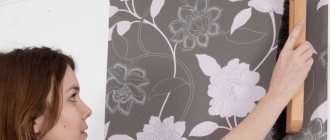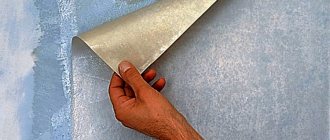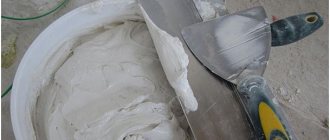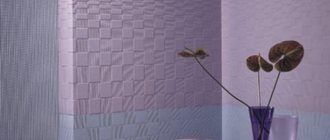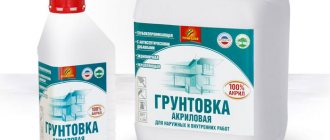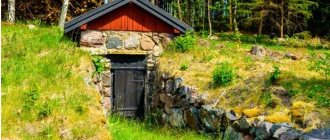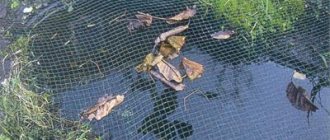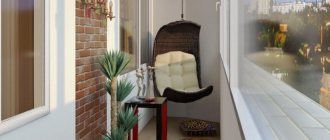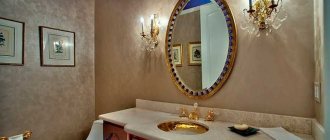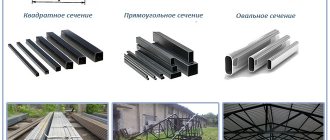Construction mixtures help level the surface before continuing work. They are presented in a wide range. You need to understand how wallpaper putty differs from plaster, and you should also learn how to use this material correctly. Before performing finishing work, it is necessary to carefully level the surface, for which only certain compositions are suitable.
How does putty differ from plaster?
The names of the materials are partly similar, but the structure is significantly different.
The difference lies in the purpose and properties:
- putty mixtures
(aka putty) are used to level surfaces that have only minor defects - small cracks, chips, unevenness and level differences of up to 1 cm;
- plaster
designed to remove more significant defects, it is used to level surfaces with level differences at different points of up to 15 cm, respectively, such mixtures are used for work on rough foundations, in addition, they often exhibit thermal insulation properties and protect the supporting structure/partition from moisture .
The structure of starting mixtures for putty is looser. This is due to the fact that in most cases the finishing composition will be applied on top. Such materials, on the contrary, create a smooth coating. Their structure is fine-grained. As a result, when leveling, grains on the surface are not visible. This option is suitable for putty under wallpaper.
Required Tools
Before starting work on leveling the walls, you should find out what tools you will need:
- spatulas of several sizes: wide (40-50 cm) and small, as well as an angular option;
- a drill with a special attachment for preparing a putty mixture;
- brushes and rollers for priming walls;
- metal rule for leveling the starting layer;
- building level - helps to control the correct verticals of the walls;
- sandpaper or mesh for grouting transitions and bumps;
- containers or buckets for mixing the solution.
What materials will be needed to level the walls?
The choice is made taking into account the condition of the surfaces.
If necessary, significant defects are removed using plaster. But it should be borne in mind that this material will not be able to remove small cracks - large fractions in the composition make it difficult to obtain a smooth surface and completely fill the area with unevenness. On the contrary, starting putty can eliminate more significant defects.
This feature expands the scope of application of the material.
In addition, to level the walls you will need:
- starting and finishing putties
, most often such materials are used in tandem, because they complement each other’s properties;
- primer composition:
ensures reliable adhesion of subsequent layers (starting putty with plaster, finishing coat with starting putty, as well as wallpaper), selected taking into account the properties, it is best to use a primer with antiseptic additives;
- reinforcing tape:
used when finishing drywall - this method is used to increase the reliability of the areas where the joints of gypsum board sheets are located;
- wallpaper
: not only are selected taking into account personal preferences, but also take into account the condition of the base surface; the smaller the defects, the wider the choice of decorative coating, since some of its varieties exhibit more unevenness, which worsens the appearance.
Calculation of putty
To immediately buy the required amount of material, they use either an online calculator or calculate on their own, guided by an algorithm of actions. With a layer thickness of no more than 4 mm per 1 m², 1 kg 200 g is required.
The figure may vary; more accurate data is indicated on the packaging of the specific material.
How to calculate the required amount of putty in order to prepare all the walls:
- Measure the length of the wall horizontally and vertically and multiply these two values. Get the area. Since there are two identical walls, the result obtained is multiplied in half.
- Then another wall is measured, the result obtained is also multiplied by two walls. Both results are added. Get the total area of the walls.
- 1 kg 200 g multiplied by the area, the number of kilograms is obtained.
Depending on how many kilograms the bags are packaged in, the resulting figure is divided by the weight of the bag to find out their number.
Calculation of the required amount of putty
Types of putty for interior decoration of premises, walls in an apartment - choose which one
First, pay attention to the composition of the material.
The main components are:
- gypsum;
- cement;
- lime;
- polymer material;
- adhesive base.
Each of them has features. When choosing putty before gluing wallpaper, take into account that gypsum compositions are characterized by plasticity and high drying speed, but this type of coating is not strong enough and absorbs moisture.
Cement compositions
They are reliable, but are subject to shrinkage during drying. They can be used for work in rooms with high humidity. Cement putty is also suitable for wallpaper. Cement mixtures are often used to level brick and concrete walls.
Lime compounds
are also used, but less often than others. This is a simple material that can be used for leveling and finishing surfaces. The mixture is plastic, thanks to the cement in the composition it gains strength.
Polymer plaster
- a suitable option for finishing putty. Used to fill various irregularities (chips, cracks). The material is characterized by plasticity, due to which it can withstand significant shrinkage deformations of structures.
Adhesive compositions
cover the surface evenly, resulting in a thin protective layer. At the same time, the mixture levels the walls and eliminates minor defects. It is used to cover concrete, wooden structures, as well as plastered walls (and in the case of applying starting putty), including cases when it is planned to glue wallpaper on top.
Starting putty for walls: which is better
This type of material is used in cases where there are small but visible defects. Any irregularities will appear under the wallpaper. In the kitchen, you should use a composition that is resistant to moisture. Then the putty walls will remain attractive for a long time. If you plan to use a cement mixture, first prime the base; without this, the adhesion of the materials will be worse in this case.
When working with starting putty for walls under wallpaper, take into account the permissible level difference - from 3 to 20 mm. Surfaces with such features will be easy to level using this type of material.
For work in rooms where the humidity level does not exceed normal, it is permissible to consider compositions with the designation KR on the packaging.
To decide which putty to choose for walls under wallpaper, it is recommended to study the rating of the best manufacturers of ready-mixes.
Among them:
- Knauf
— the material is applied in small quantities, as it smoothes out defects well, the maximum layer is up to 1.5 cm;
- Osnovit-Ekonsilk
— it is important to apply a coating no thicker than 1 mm, otherwise cracks will appear when drying;
- Volma-Standard
— suitable for dry rooms, because it contains gypsum.
Finishing putty: which is better
It must be remembered that large defects cannot be leveled using such material. The finishing putty will retain its properties if applied in small quantities. Moreover, it is important to follow the operating rules (taking into account air parameters) in order to extend the service life of the coating.
Rating of the most suitable compositions:
- Knauff
— Uniflot wall putty. The mixture does not shrink when dried; on the contrary, it only gains strength. Available in durable bags containing dry mixture.
- Fugenfüller (Knauff)
. It is used to eliminate gaps, small cracks, as well as joints between sheets of drywall. This is a harmless material that has no odor.
- Rotband
. Another type of composition of the Knauff brand. It is a gypsum putty. The permissible layer thickness is from 3 to 10 mm. The disadvantage is the high drying speed. This means that you can work with the finished mixture for no longer than 20 minutes.
- Ceresit
. Consider different materials of this brand. It is recommended to prime the surface first. Such mixtures behave better when applied to moistened brick or concrete walls, which is explained by their porous structure.
- Eunice
. Along with Knauff brand materials, such compositions are characterized by whiteness, which is considered a good indicator. Another advantage is high ductility.
- Weber veronit
- a good budget option. But this material has a drawback - low drying speed. In addition, it is used for finishing walls in rooms with low humidity levels.
Finishing putty for wallpaper: which one is better?
If the decorative coating is dense enough, it is not necessary to smooth out the smallest defects. The drawing will further hide them. But in most cases, the wallpaper shows almost all the irregularities, so it is better to prepare the surface.
When choosing which putty is best for walls under wallpaper, first of all pay attention to the following options:
- gypsum (for dry rooms);
- latex - universal mixtures.
Manufacturers chosen are Vetonit and Knauff. The compositions are similar in properties.
Advantages of the products of these brands:
- smooth surface after leveling;
- Easy to process; to remove unevenness then just use sandpaper.
Disadvantages include moderate adhesion and low strength. But, given that wallpaper does not contribute to the weight of the supporting structure/partition, it is not necessary to use compositions with an increased level of reliability.
How to do the work yourself?
- At the preparatory stage, cracks on the surface must be widened and oil stains must be degreased.
- Deep cracks are filled with polyurethane foam, acrylic sealant, recesses up to 5 mm are filled with starting putty with a serpyanka gasket.
- Copper in the room should be covered with insulating material (polyethylene).
- After the fragmentary finish has dried, use a construction vacuum cleaner to remove dirt and dust.
Puttying process:
- Apply 2 layers of concrete contact with a drying break.
- Apply the primer with a long-haired nylon or fur roller.
- Apply a strip of mounting adhesive along the width of the reinforcing mesh (1 m) with an allowance of 5 cm at the edges.
- Fix the fiberglass at the top edge of the wall, using a herringbone motion, remove bubbles with a plastic spatula.
- Accelerate the air, moving from the middle to the edges, do not press on the tool.
- Apply 1 layer of penetrating primer, wait until dry (3-4 hours).
- Mix the solution with a construction mixer until there are no lumps and a paste-like consistency.
- Follow the instructions on the package, the average proportions are 5 liters of water per 25 kg of mixture.
- Let the solution sit for 3-4 minutes, stir again.
- Using a 450 mm spatula, apply a layer of the starting composition to the strip without pouring.
- Apply the composition with horizontal or vertical movements in the direction of lighting.
- Maintain a thickness of 1-1.5 mm, cut off the solution with a spatula immediately after application.
- After the starting coating has dried, apply 2-3 layers of the finishing solution in the same way.
- After the final coating has dried, sand the surface using a circular float with a P180 nozzle.
Reinforcing mesh is necessary to prevent cracking of the putty and enhance adhesion. If the surface is being prepared for wallpaper or panel cladding, then sanding can be neglected. Before decorative finishing, apply 1-2 layers of penetrating primer. After sanding, it is recommended to dust the surface with a construction vacuum cleaner. Do not use a damp cloth.
Putty for concrete surfaces must have elasticity and thixotropy (liquefaction and increase in viscosity when drying).
Attention
Acrylic compositions are suitable for wet rooms and facade work, and gypsum compositions are suitable for interior work.
How to properly putty a wall for wallpapering - step-by-step instructions for applying to plaster
It is necessary to determine the alignment method:
- starting putty;
- finishing;
- combined option (involves alternate application of starting and finishing mixtures).
In the first case, a starting solution is sufficient, but this option does not allow obtaining a smooth surface. If the wallpaper is thick, with a bright relief pattern, you can use this method to level the walls. But this option is used less often than others.
The most common methods: applying only the finishing mixture, using a combined method. The difference between them is the need to use starting putty. This material does not need to be used if the rough base is smooth and has no obvious defects. Small irregularities are removed with the finishing mixture.
If the question of which putty is best to putty on walls under wallpaper is being decided, most often a combined option is considered. This is due to the fact that when constructing objects, workers do not always carefully level the surfaces. As a result, streaks and sagging remain, and level differences are formed in different sections of the wall. Such defects are corrected in 2 approaches: first, apply the starting mixture, then the finishing mixture.
Puttying the walls before wallpapering is done several times, but it is important to wait until the previous layer has dried. Only then the next one is applied.
Is it necessary to putty the walls before wallpapering with starting and finishing putty?
This is the classic alignment method. It is always used whenever possible. This will allow you to withstand the technology of wall finishing. One of the problems that is solved in this case is to strengthen the supporting structure, which will make it possible to support decorative finishing of significant weight. But if the question of how to glue wallpaper is resolved, then there is no need to apply different types of putty. This is a light coating, so often only the finishing mixture is used.
Advantages of puttying walls under wallpaper:
- increased adhesion;
- reduction of glue consumption;
- elimination of minor defects.
Wallpaper cannot be glued to plaster without additional coating. A coarse-grained mixture will prevent the material from being properly fixed. Due to low adhesion, the wallpaper will soon come off the wall. The starting mixture before the finishing mixture is most often used on top of brickwork and concrete structures. The result will be the same as in the case of gluing wallpaper over plaster, i.e. not very good. The service life of the decorative coating will be reduced.
Do I need to prime the walls before puttying?
The first mandatory step is the use of leveling mixtures. Priming is another way to improve the properties of the rough base.
This composition simultaneously solves several problems, including:
- normalization of the absorbency of the treated surface, which allows reducing the consumption of wallpaper glue;
- increasing the adhesion of the material to the rough base;
- reducing putty consumption (walls are primed before and after leveling);
- strengthening the surface layer of the coating, which does not allow the putty to crumble, and this is an important nuance when working with wallpaper;
- providing protection against fungus and moisture.
If for some reason it is not possible to use a primer or the information on how to properly putty walls under wallpaper was not studied in time, then you are still allowed to proceed to finishing with decorative material, skipping this stage. But as a result, it will be difficult to predict how the coating will behave in this case.
Wall putty tool
Often the leveling material is produced in the form of a dry mixture. Learning how to prepare a working solution is much easier if you have a special tool. When mixing the mass with your own hands, mistakes are made, which leads to a decrease in the quality of the finished material. But this is the only way to gain experience in working with building mixtures. If you don’t have time to experiment, you can immediately move on to finishing.
Tools for finishing putty on walls under wallpaper with your own hands:
- drill with a special attachment - mixer;
- spatulas of different lengths, with smooth and serrated edges;
- rule;
- building level, plumb line;
- roller and brushes;
- special devices, materials for removing minor defects after the putty has dried - sandpaper, graters;
- container in which the solution will be mixed.
How (how many times) to apply putty to the wall before wallpapering - technology
Sequencing:
- Prepare a solution (instructions are given by the manufacturer of each type of material); there is no universal scheme for mixing putty with water. The consistency is always the same - creamy.
- Starting putty is applied to the primed surface. To do this, use a wide spatula. It is held in the hand at an angle of 30°, the direction of movement is diagonal to the wall.
- The next layer is finishing putty under the wallpaper, applied after priming. The break between leveling processes is from 12 to 24 hours. You need to wait until the starting mixture is completely dry. Use large and small spatulas. The thickness of the layer depends on the type of material (1-10 mm). The resulting surface should be smooth. If necessary, apply several layers. Each of them is primed.
Use sandpaper or a grater to remove small irregularities. This should be done when the top layer of material has dried.
Is it possible to apply putty to level walls on paint?
The use of paints and varnishes allows you to create an impermeable film on the surface of the supporting structure/partition. If you try to apply the building mixture on top, it will not stick. It’s better not to even deal with the issue of how to putty the walls with your own hands. The quality of fixation of the decorative coating will be below average.
If possible, remove paint. Water-based is easy to wash off. Other types of coatings are removed as thoroughly as possible using special compounds that destroy the paint, or using mechanical action (scratching, sanding).
Maximum layer of putty on walls after plastering
The following options are being considered:
- apply several layers with a thickness of 0.5-3 mm, this facilitates the leveling process, but the implementation of the method takes more time and increases the consumption of the mixture (this option can be used by beginners in the construction business);
- many layers of smaller thickness are applied - up to 0.5 mm, the number of stages when creating a coating often reaches 5 or more, this option is more difficult to implement.
Grouting walls after puttying - detailed instructions for beginners
If minor defects remain on the surface, there is no need to reapply the leveling mixture.
Just follow the instructions:
- Treat uneven areas with coarse sandpaper.
- Even smaller defects are smoothed out with fine-grained sandpaper. If there are a lot of irregularities, you can immediately take a mesh for sanding. It does not clog as quickly as the previously discussed tool.
- Sanding is carried out at each leveling stage, when the next layer of putty dries.
- During work, you should not enter an already treated area, this will lead to the appearance of depressions and new irregularities.
They check the quality of grinding using a flashlight - they illuminate the surface with it, even if the work is done in good light during the day.
Overhead light does not contribute to the appearance of all defects. When the work is completed, remove the microparticles that have separated from the coating.
Preparing the surface for puttying, sealing cracks
Before starting all work, cover the floor, baseboards, and window sills with plastic wrap - since dried putty cannot be removed without damaging the surface. Then clean the surface of the old coating, go over it with sandpaper to remove crumbs and burrs, and use a spatula to remove the plaster buildup. After this, prime the surface, wait at least 2 hours, and only after this time, begin to seal deep holes, cracks and strong differences with starting putty.
Question:
How to putty seams and cracks?
Answer:
To putty seams and cracks, use a spatula of at least 10 cm in size. You need to apply the solution to the seam, wait until it dries, and then putty again, since the putty can shrink. To putty walls with deep cracks, use a gypsum or alabaster mixture, but you need to work with it very quickly.
Which putty for interior work should you choose for walls for wallpapering?
Among the variety of materials, you need to choose the right composition that is most suitable for working under the given conditions.
When you putty walls under wallpaper with your own hands, it is best to use the following types of mixtures:
- gypsum;
- polymer;
- cement.
The properties of each option were discussed above. At this stage, the value for money is assessed. The mentioned mixtures are the most suitable, especially if you have to level a large surface area.
The choice is also made taking into account the structure of the material. There are ready-made mixtures and dry formulations. It must be remembered that the first option cannot be used for leveling walls; if you have to apply a layer more than 2 mm thick, this will lead to deformation of the coating due to shrinkage.
Is reinforcing mesh necessary?
You can often come across the opinion that wallpaper additionally strengthens the surface of the wall and therefore there is no need to use reinforcing materials when filling. This is only partly true; this rule is not true for all types of bases and types of wallpaper.
As a rule, reinforcing putty is practiced when preparing walls for painting in order to eliminate the formation of cracks that cannot be hidden in any way. Exactly the same approach should be practiced if the decoration will be carried out with thin, light-colored wallpaper, for example, paper or vinyl on a non-woven backing. In addition to the fact that cracks can show through the canvas in the form of dark stripes, they can also lead to rupture of the wallpaper itself.
Continuous reinforcement of the wall surface is not required in panel-type houses or if the base is made of sheet materials. You can also avoid laying mesh in putty if the house stands on a reliable foundation and is made of large-sized masonry material with a small joint thickness, for example, aerated concrete blocks. Reinforcement of the finishing layer is required when processing brick walls, especially those made of half a brick. It is also possible to recommend strengthening the entire surface of walls in secondary housing facilities and private houses over 30 years old. In panel houses or if the base is made of sheet materials, gluing one or two layers of reinforcing mesh in the corners and joints is required.
What is mandatory when puttingtying walls is priming. It is carried out twice on the rough surface, and then intermediately before applying each new layer. For priming under putty, use acrylic-based adhesive primers. Since the putty layer is minimal, it is not necessary to limit the moisture absorption of the base.
Why do you need putty: is it possible to do without it?
When people find out how much it costs to putty walls, many want to bypass this process, because it is unnecessary financial costs and labor. But you won’t be able to neglect the repair conditions if you need perfectly smooth walls.
Irregularities are present on the walls, and the pasted wallpaper perfectly demonstrates this defect
The starting putty will hide large defects, and the finishing putty will prepare the leveled surface for wallpapering, and even the ceiling, if necessary.
Conclusion
From the article you learned how to ideally prepare walls for photo wallpaper, regular wallpaper and other adhesive coverings. As you can see, there is nothing complicated in the process. The main thing is to get down to work and follow all the recommendations. The video in this article will help you understand the topic even better, and if you have questions or clarifications, write them in the comments.
Did you like the article? Subscribe to our Yandex.Zen channel
December 23, 2021
Wallpaper, Finishing materials, Construction Chemicals, Plaster and wall putty
If you want to express gratitude, add a clarification or objection, or ask the author something, add a comment or say thank you!
Start, finish or universal?
The starting lineup is rougher, with a larger faction. It is used in the presence of noticeable irregularities, local chips and cracks more than 3 mm deep.
Finishing putty with a fine fraction. It creates a thin, perfectly even layer.
Universal is also of a “fine” fraction. It replaces both compositions.
If the base requires serious leveling, use the starting composition in combination with the finishing composition or a universal composition.
If the surface is smooth, finishing putty is sufficient.
All polymer compositions are universal.
